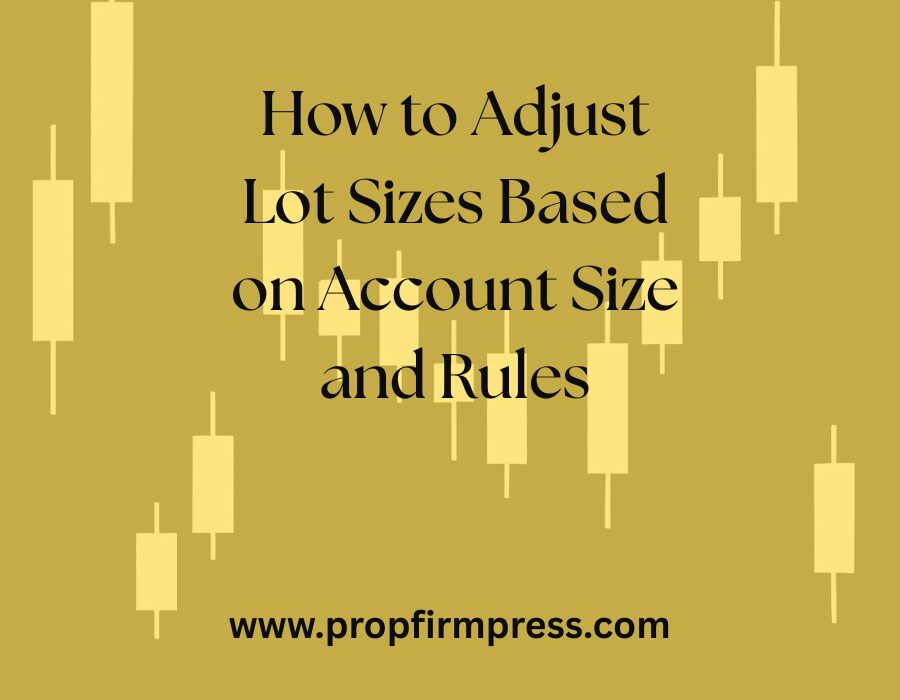Why Lot Size Matters More Than You Think
Lot size is the core of trade management. For traders in prop firm evaluations, it’s not just about picking a winning direction—it’s about how much risk you’re taking relative to your account size and the firm’s rules. One oversized position can trigger a violation. But properly adjusted lot sizes can help you hit profit targets while staying safe.
Step 1: Understand the Account Size You’re Trading
Whether you’re trading a $25K, $50K, or $100K account, the lot size should never be arbitrary. It’s always a function of your max allowable drawdown, not just your total equity. For example, with a $100K account and a $3,000 max loss, you’re effectively managing a $3K risk pool—not the full $100K.
Step 2: Know the Firm’s Risk Rules
Every firm has specific rules on drawdowns, daily limits, and contract caps. Some use trailing drawdown (like Instant Funding), while others like The 5%ers have fixed equity loss models. Before sizing, make sure you understand:
- Daily drawdown limit
- Trailing vs static rules
- Maximum position size per instrument
Step 3: Use a Risk Percent Per Trade Formula
Most funded traders use 0.5% to 1% risk per trade. For a $50K account with a 5% drawdown limit, your effective risk pool is $2,500. At 1% per trade, you’d risk $500 max. With a 10-point stop on the ES contract, you’d trade 1 lot max. Adjust the lot size downward if the stop is tighter.
Step 4: Calculate Based on Instrument Volatility
Different instruments require different lot sizes. Crude oil (CL) is more volatile than micro S&P (MES). Even if your risk tolerance is constant, your lot size should change depending on:
- Stop loss size in ticks
- Dollar value per tick
- Instrument volatility
Use a calculator (like the free one at Prop Firm Press) to run numbers before each trade session.
Step 5: Don’t Scale Up Too Early
Just because you’re halfway to your profit target doesn’t mean you should double your lot size. Many traders blow evaluations by overestimating their edge after a few wins. Stay with your base size until you’re comfortably in profit and the account can absorb an average losing trade without breaching limits.
Step 6: Downsize During Volatile News Periods
On CPI, NFP, or FOMC days, reduce lot size or skip trading. Even setups with high win rates can fail due to whipsaw volatility. You’ll often see funded traders at Prop Shop Traders and Funded Futures Network scale down or stay flat during news.
Step 7: Use Micros for Precision
If you’re near a profit milestone or just returning from a drawdown, switch to micro contracts. The MES, MNQ, and MCL allow traders to manage risk in $5 or $10 increments—perfect for fine-tuning without taking big hits. Micros let you trade without violating rules while still progressing.
Step 8: Adjust Based on Time of Day
Lot size can be context-driven. During volatile opens or key sessions, consider cutting size in half. For example:
- First 30 minutes of NY open: trade half size
- After lunch lull: normal size
- During closing hour: only trade A+ setups with full size
Step 9: Use a Pre-Trade Lot Size Checklist
Ask yourself before every trade:
- What’s my stop in points/ticks?
- What’s the dollar risk per contract?
- Is this aligned with my max per-trade risk?
- Does this lot size work within today’s drawdown room?
Step 10: Journal Your Lot Size Decisions
Track lot sizes in your daily trade journal. Log what size you used, why, and what happened. Over time, you’ll identify patterns—maybe you size too large on revenge trades, or too small on high-probability setups. Use this feedback loop to tighten discipline.
Lot Size Discipline Equals Evaluation Survival
In prop trading, it’s not the trader with the best predictions who gets funded—it’s the one who manages risk with razor-sharp precision. Lot size isn’t just a number; it’s a reflection of your discipline, math, and ability to follow rules under pressure. Adjust it carefully, and you’ll stay in the game long enough to win.
